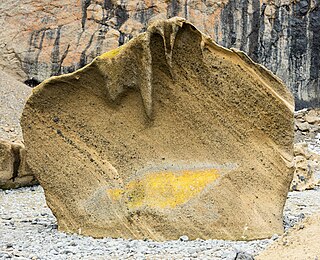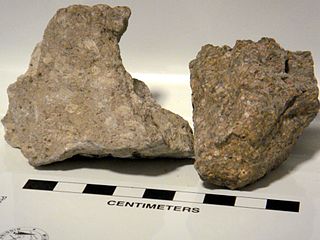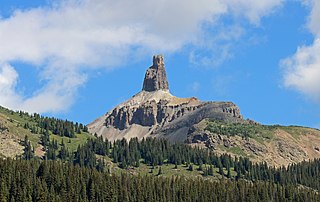 W
WTephra is fragmental material produced by a volcanic eruption regardless of composition, fragment size, or emplacement mechanism.
 W
WA cinder is a pyroclastic material. Cinders are extrusive igneous rocks; they are fragments of solidified lava. Cinders are typically brown, black, or red depending on chemical composition and weathering. Cinders are similar to pumice.
 W
WAn eruption column or eruption plume is a cloud of super-heated ash and tephra suspended in gases emitted during an explosive volcanic eruption. The volcanic materials form a vertical column or plume that may rise many kilometers into the air above the vent of the volcano. In the most explosive eruptions, the eruption column may rise over 40 km (25 mi), penetrating the stratosphere. Stratospheric injection of aerosols by volcanoes is a major cause of short-term climate change.
 W
WFiamme are lens-shapes, usually millimetres to centimetres in size, seen on surfaces of some volcaniclastic rocks. They can occur in welded pyroclastic fall deposits and in ignimbrites, which are the deposits of pumiceous pyroclastic density currents. The name fiamme comes from the Italian word for flames, describing their shape. The term is descriptive and non-genetic.
 W
WIgnimbrite is a variety of hardened tuff. Ignimbrites are igneous rocks made up of crystal and rock fragments in a glass-shard groundmass, albeit the original texture of the groundmass might be obliterated due to high degrees of welding. The term ignimbrite is not recommended by the IUGS Subcommission on the Systematics of Igneous Rocks.
 W
WLapilli is a size classification of tephra, which is material that falls out of the air during a volcanic eruption or during some meteorite impacts. Lapilli is Latin for "little stones".
 W
WLizard Head is a mountain summit in the San Miguel Mountains range of the Rocky Mountains of North America. The 13,119-foot (3,999 m) thirteener is located in the Lizard Head Wilderness, 6.8 miles (11.0 km) west by south of the Town of Ophir, Colorado, United States, on the drainage divide separating San Juan National Forest and Dolores County from Uncompahgre National Forest and San Miguel County.
 W
WTephrochronology is a geochronological technique that uses discrete layers of tephra—volcanic ash from a single eruption—to create a chronological framework in which paleoenvironmental or archaeological records can be placed. Such an established event provides a "tephra horizon". The premise of the technique is that each volcanic event produces ash with a unique chemical "fingerprint" that allows the deposit to be identified across the area affected by fallout. Thus, once the volcanic event has been independently dated, the tephra horizon will act as time marker.
 W
WTuff is a type of rock made of volcanic ash ejected from a vent during a volcanic eruption. Following ejection and deposition, the ash is lithified into a solid rock. Rock that contains greater than 75% ash is considered tuff, while rock containing 25% to 75% ash is described as tuffaceous.
 W
WTuffite is a tuff containing both pyroclastic and detrital materials, but predominantly pyroclasts.
 W
WVolcanic ash consists of fragments of rock, minerals, and volcanic glass, created during volcanic eruptions and measuring less than 2 mm (0.079 inches) in diameter. The term volcanic ash is also often loosely used to refer to all explosive eruption products, including particles larger than 2 mm. Volcanic ash is formed during explosive volcanic eruptions when dissolved gases in magma expand and escape violently into the atmosphere. The force of the gasses shatters the magma and propels it into the atmosphere where it solidifies into fragments of volcanic rock and glass. Ash is also produced when magma comes into contact with water during phreatomagmatic eruptions, causing the water to explosively flash to steam leading to shattering of magma. Once in the air, ash is transported by wind up to thousands of kilometres away.
 W
WA volcanic bomb is a mass of molten rock (tephra) larger than 64 mm (2.5 inches) in diameter, formed when a volcano ejects viscous fragments of lava during an eruption. They cool into solid fragments before they reach the ground. Because volcanic bombs cool after they leave the volcano, they are extrusive igneous rocks. Volcanic bombs can be thrown many kilometres from an erupting vent, and often acquire aerodynamic shapes during their flight. Bombs can be extremely large; the 1935 eruption of Mount Asama in Japan expelled bombs measuring 5–6 m in diameter up to 600 m (2,000 ft) from the vent. Volcanic bombs are a significant volcanic hazard, and can cause severe injuries and death to people in an eruption zone. One such incident occurred at Galeras volcano in Colombia in 1993; six people near the summit were killed and several seriously injured by lava bombs when the volcano erupted unexpectedly. On July 16, 2018, 23 people were injured on a tour boat near the Kilauea volcano as a result of a basketball-sized lava bomb from the 2018 lower Puna eruption.